News
Interview with Joyce Lee
 Image credit: Joyce Lee / NYC Department of Design & Construction
Image credit: Joyce Lee / NYC Department of Design & Construction
In a recent talk, Dr. Richard Jackson, former head of the National Center for Environmental Health at the CDC, said there are “deep-rooted structural issues with the built environment that are creating epidemics of obesity, diabetes, and depression.” How will New York City’s new Active Design Guidelines solve these major problems?
We take the message of health practitioners very seriously and have started re-visiting the way we plan, design, and build. “Deep-rooted” is true -- we subscribe to a culture of design and planning.
Our Commissioner, David J. Burney, had the vision of creating best practices through a set of design guidelines based in research and evidence.
Active design addresses both outdoor and indoor environments. The guidelines have chapters on health and the built environment, urban design and building design strategies, and synergies with sustainable design and universal design. Working together across sectors and disciplines, with the collaboration of landscape architects, we think we have a fighting chance to solve these major problems.
When many people think of New York City, they think of busy, rushed walkers and subway riders. But we see from the guidelines that the real picture is quite different and major parts of the city are stuck in their cars and facing the same epidemics as the rest of the country. How do the obesity and diabetes rates differ across the city? Do these rates closely correlate with location or income?
Our central business districts are often congested like those in any other world city. Not only does congestion create a loss of productivity but we also now know it impacts health in several dimensions. Just as obesity affects different states in the country, the obesity and diabetes rates differ in neighborhoods across New York City. Socioeconomics and access to parks and recreation, transit, healthy food all have roles to play.
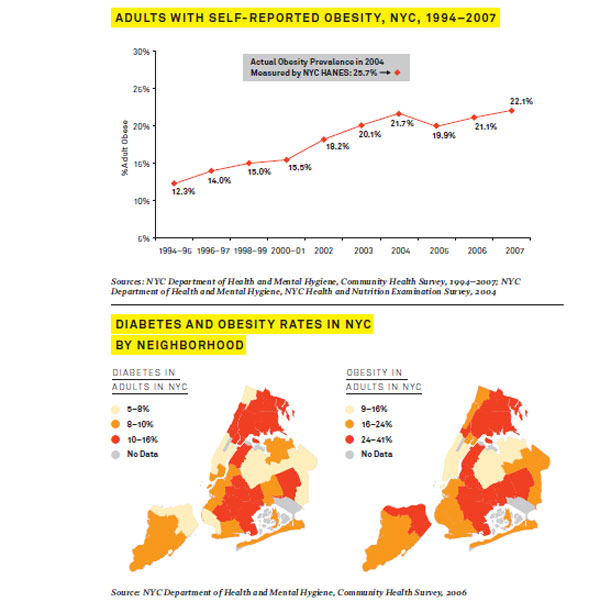 Image credit: Obesity rate maps. NYC Active Design Guidelines
Image credit: Obesity rate maps. NYC Active Design Guidelines
We often talk about design tools. One of the most important tools for me working with health professionals is the actual obesity map of New York City. Subsequently, I've seen similar maps for Washington, D.C. and other communities. They tell a compelling story of how we have to tailor active design to different neighborhoods. Access to active transportation and recreation vary. By understanding these local factors, we can think about whether parks should have more active vs. passive areas or whether schools should use their rooftops differently.
The unifying factor, though, could be the streets because they connect neighborhoods. We already know that streets could be safer by design. There are graphic examples of traffic island design, curb cut considerations, and bicycle infrastructure in the guidelines. Additional references can be found in DOT’s Street Design Manual, also published during the administration of Mayor Michael Bloomberg.
The guidelines say there is great overlap between active, sustainable, and universal design. Today, a well-designed park like the High Line is expected to meet the requirements of all three disciplines. What’s the direct connection between active design and sustainability?
Yes, the High Line on the westside overlooking the waterfront is a prime example. Active design often reduces our carbon footprint. If you walk the length of the High Line, you save yourself a subway ride, let alone a car trip. Even though we do not yet have a study, one can imagine the mental health benefits taking in the views and landscape design.
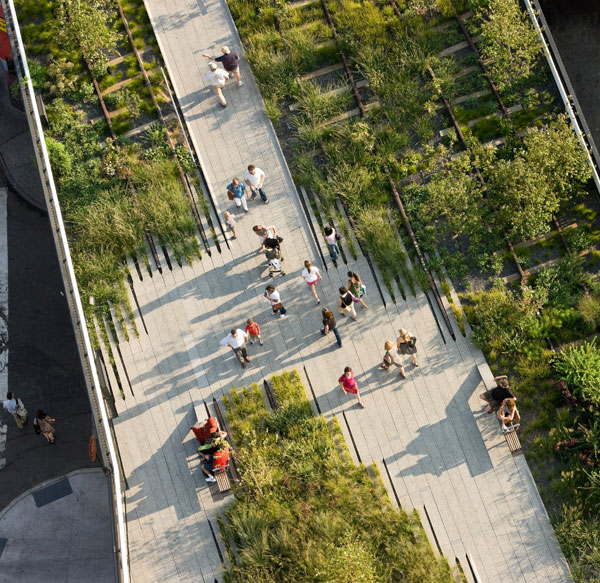 Image credit: High Line Park, New York City / Iwan Baan
Image credit: High Line Park, New York City / Iwan Baan
In the LEED for Neighborhood Development (LEED-ND) rating system, active design is pervasive in credits such as bicycle network and storage, walkable streets, access to recreation facilities and tree-lined and shaded streets. Shading from trees and energy savings have direct correlations. In New York City's streets, you can find sidewalk installations with bicycle parking, seating, and a raised grating for subway stormwater management all in one.
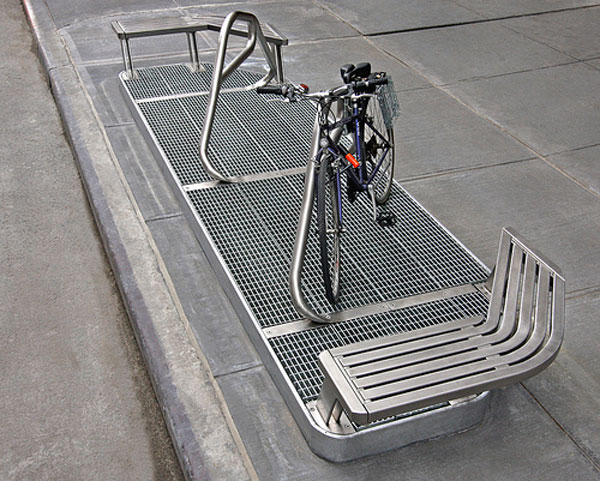 Image credit: MTA Bike Rack by Grimshaw Architects / Municipal Arts Society of New York
Image credit: MTA Bike Rack by Grimshaw Architects / Municipal Arts Society of New York
Another direct connection we have created is the LEED Innovation Credit for Physical Activity, which was used in projects like the Department of Design and Construction (DDC)’s Riverside Health Center and an affordable housing project in the Bronx, Via Verde, which is expected to be certified LEED Gold by the U.S. Green Building Council. The goal is to reduce TV time by creating active recreation areas, and reducing elevator use by encouraging stairs.
The guidelines are voluntary. Is the goal to make these approaches mandatory for new projects in NYC and across the U.S.? What do you see as the pluses and minuses with integrating these recommendations into community landscape codes?
The guidelines were only launched in 2010. The positive feedback is very encouraging. We are fortunate to be able to apply them immediately to projects in New York City and beyond. New York City can advance the objectives of the guidelines in other communities by merely demonstrating its commitment.
It may be a little early to discuss the pros and cons of integration with community landscape codes as we are receiving feedback from each project and still working with designers and policy makers. The lessons learned from a portfolio of projects will undoubtedly be the best guide to our next steps. Recommendations for pilot projects from landscape architects are welcome.
Working with the health department and using CDC funds, your department is now helping other cities adapt the guidelines to their own scenarios. Major cities like San Diego, Miami, and Boston along with smaller cities like Birmingham have already signed-on. Are the challenges facing larger and smaller cities trying to incorporate active design approaches different?
We are very early in the process and certainly understand scales matter. One major achievement of the guidelines has been to start a dialogue on active design in municipalities of all sizes. While larger cities have more resources, smaller cities can move policies faster. Think of all the towns and cities that have bicycle lanes already.
Based on the feedback to date, we also see the need for guidelines for suburban and rural communities and are looking for resources to implement this next phase. Another consideration is the different climates in the country. You pointed out geographically diverse cities. Outdoor summer and winter play are especially important to growing children and we have to be mindful of the settings and temperature conditions. Devising active transportation and recreation opportunities for indoors and outdoors, adults and children, are parallel goals that we are pursuing. Easy and affordable access is key.
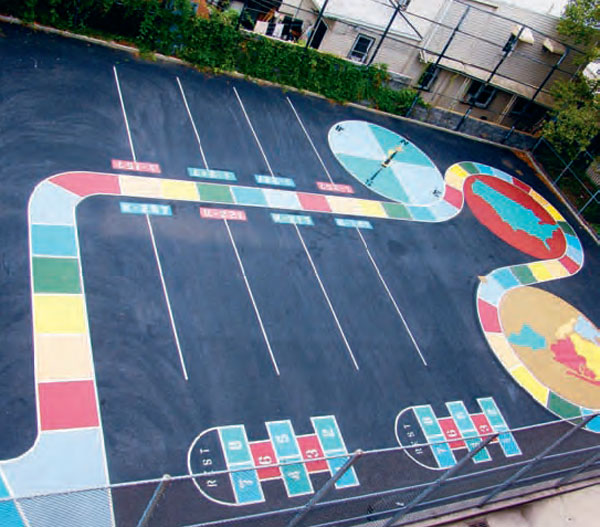 mage credit: Public School 64, Queens. Thomas Balsley Associates
mage credit: Public School 64, Queens. Thomas Balsley Associates
The guideline’s urban design checklist starts at the broad scale. For example, the guidelines call for mixed land-uses; putting homes and workplaces near green spaces, recreation areas, and supermarkets; facilitating easy connections with a variety of transportation networks; and designing open spaces. However, these types of fixes can be expensive for smaller communities that have already sunk a lot of money into their infrastructure. How can communities retrofit themselves for active living in a low-cost way?
The guidelines are principles-based because we know that adaptations in different communities are important over time. Collaborations with planning and transportation departments is highly encouraged because the opportunity for large-scale change is critical to improving public health. Bringing active design and health into the conversation during zoning, transportation boards, and commissions meetings could be catalytic.
While planning efforts like those in the DCP’s Bicycle Master Plan and the Waterfront Comprehensive Plan in our city are very effective, active design can also be integrated in a variety of retrofit projects. We are seeing the success of new green streets and pedestrian plazas.
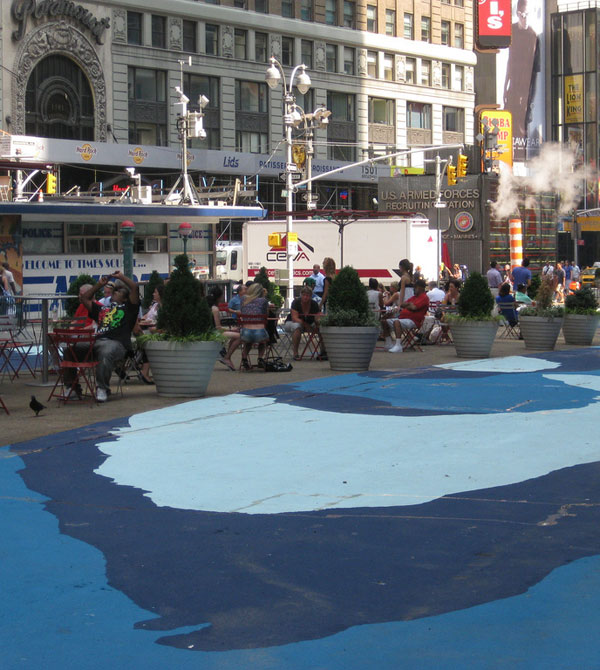 Image credit: Times Square Pedestrian Plaza / NYC Department of Transportation
Image credit: Times Square Pedestrian Plaza / NYC Department of Transportation
Another low cost strategy is turning passive outdoor space into active space. Childhood obesity is now a national conversation. Even with incremental changes in every project, they become permanent opportunities for people to become active. Fortunately, population health is measured over time.
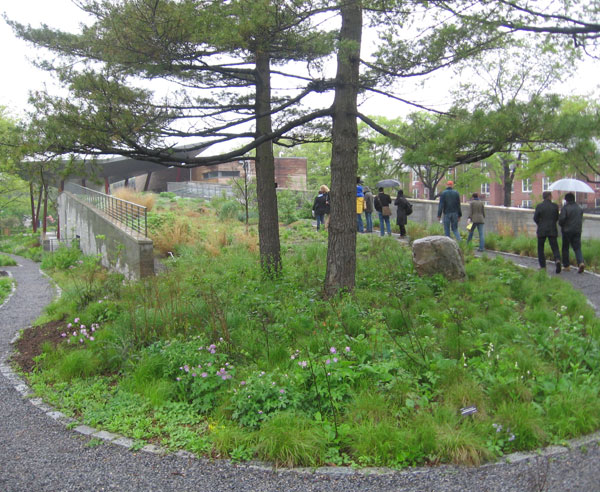 Image credit: Queens Botanical Garden Sustainable Landscape / Conservation Design Forum, Elmhurst, Illinois
Image credit: Queens Botanical Garden Sustainable Landscape / Conservation Design Forum, Elmhurst, Illinois
Getting down to the nitty-gritty of street design, the guidelines also make specific recommendations for street calming, pedestrian pathway design, street-level programs like cafes and public art, and bicycle infrastructure. Can you name a couple active living design strategies you think landscape architects must look out for?
While there are specific recommendations, the guidelines are not meant to be prescriptive and we welcome the creativity of landscape architects in what you term street-level programs. We offer ample illustrations of what works well in New York City.
Landscape architects can bring active living design strategies to a focus in many areas. For example, playground and natural and walking trail design are fertile grounds for further exploration. Bicycle trails and lanes are opportunities to collaborate with transportation engineers and planners. Waterfront park design is a growing field for landscape architects. These projects revitalize communities. Well-designed campuses filled with native plants provide a wonderful incentive for walking. Step streets and Safe Route to Schools projects offer similar active design potential. Green roofs encourage rethinking of the space on top of buildings. Gardening and urban agriculture, popular topics for many communities, are next steps that we are exploring now. These are just a few ways to promote physical activity. I look forward to collecting additional best practice examples from landscape architects in the future.
Also, at the end of April, I am participating in the MillionTreesNYC Planting Day with DDC volunteers to help advance Mayor Bloomberg’s PlaNYC initiatives. Hopefully, landscape architects can catalyze the growth of similar local programs elsewhere and further promote active living and sustainability.
Joyce Lee, AIA, LEED AP, is the Director of the Active Design Program at the City of New York Department of Design and Construction. Download NYC's Active Design Guidelines for free. Contact Joyce about submitting landscape architecture case studies at adgleadership@ddc.nyc.gov.
Interview conducted by Jared Green.